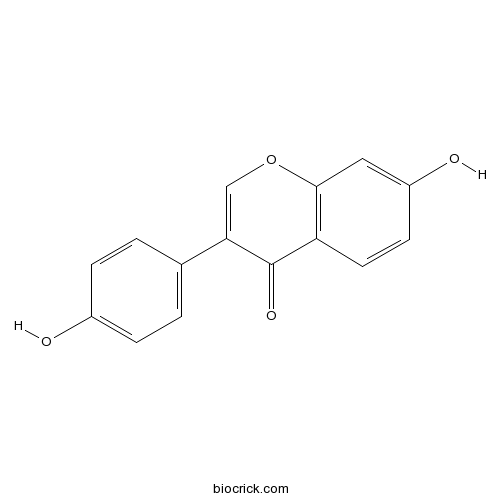A member of the class of 7-hydroxyisoflavones that is 7-hydroxyisoflavone substituted by an additional hydroxy group at position 4'.
InChI=1S/C15H10O4/c16-10-3-1-9(2-4-10)13-8-19-14-7-11(17)5-6-12(14)15(13)18/h1-8,16-17H
Daidzein and genistein glucuronides (DG and GG), major isoflavone metabolites, may be partly responsible for biological effects of isoflavones, such as estrogen receptor binding and natural killer cell (NK) activation or inhibition; DG and GG are weakly estrogenic, and they activate human NK cells in nutritionally relevant concentrations in vitro, probably at a site different from IL-2 action.[1]
Daidzein, genistein, and their .beta.-glycoside conjugates can inhibit mammary tumorigenesis in animal models of breast cancer, may have antitumor activity against breast cancer.[2]
Daidzein and daidzin can suppress free-choice ethanol intake by Syrian golden hamsters.[3]
Daidzein or 17 alpha-ethinylestradiol is more efficient than genistein in preventing ovariectomy-induced bone loss in rats.[4]
[1] Zhang Y, Song T T, Cunnick J E, et al. J Nut, 1999, 129(2):399-405.
[2] Coward L, Barnes N C, Setchell K D R, et al. J Agr Food Chem, 1993, 41(11):1961-7.
[3] Keung W M, Vallee B L. P Nat Acad Sci USA, 1993, 90(21):10008-12.
[4] Picherit C, Coxam V, Bennetau-Pelissero C, et al. J Nut, 2000, 130(7):1675-81.
[5] Zhao X, Shen Q, Ma Y. J Chromatogr B, 2011, 879(1):113-6.



